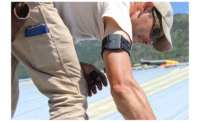Keeping an eye on weather conditions around critical infrastructure is a persistent problem for public agencies and private owners, particularly in underserved communities far from government weather stations. That was the issue faced by Pam Brownell, director of emergency management for Franklin County, Fla., a low-income coastal county in the state’s panhandle. A single bridge links the tourist spot of St. George’s Island to the mainland, and knowing when to close the bridge due to winds was a major issue, says Brownell.
“It’s a really high bridge, and we’ve had vehicles spun around up there due to wind,” Brownell says. Two years ago she got a call from a new company named WeatherSTEM that wanted to run a free pilot for its weather monitoring station.
The WeatherSTEM unit monitors temperature, humidity, air pressure, precipitation and water temperature, as well as wind speeds, both gusts and sustained. The unit runs off of solar power and has a weatherproof cellular connection. Each station not only tracks weather data but automatically pushes it live to web and social media pages without human oversight.
Since she has to close the bridge when winds exceed 40 mph and the county sheriff’s department was tired of going out in storms to measure wind speeds with handheld units, Brownell took WeatherSTEM’s offer to set up a unit by the bridge. “It’s definitely lived up to what they promised,” she says. During Subtropical Storm Alberto in May, readings from the WeatherSTEM spurred the evacuation of St. George’s Island. “It’s been a valuable tool for emergency management; everyone loves it,” she says.
WeatherSTEM is the brainchild of Ed Mansouri, a trained meteorologist who had worked in educational software. Three years ago he introduced WeatherSTEM weather monitoring units as an educational tool and sent them to schools across Florida, at least one in each of the state’s 67 counties. He soon discovered that many areas of the state had poor local weather data, and demand from towns and municipalities began to roll in.
“We started in education and moved into emergency management,” says Mansouri, who has also installed WeatherSTEM units at the University of Florida’s football stadium and other high-profile sites across the state and the greater Southeast. Many TV news broadcasts in Florida use their local WeatherSTEM for weather data. “There’s no such thing as too much weather coverage,” he says.
Mansouri has larger ambitions for the system. WeatherSTEM has begun aggregating the data from across Florida into a single online tool called OrangeSTEM, which provides statewide weather information based on the aggregate data. The information is merged with publicly available radar and satellite imagery for a more complete picture of local weather.
But for Brownell, back in Franklin County, she’d be happy if the state Dept. of Transportation would invest in a few more units. “I’m hoping DOT sees what a valuable asset this is and puts them on the rest of our bridges,” she says. “For years they’ve told me I had to first find a vendor to do this. Well, I found one!”







Post a comment to this article
Report Abusive Comment